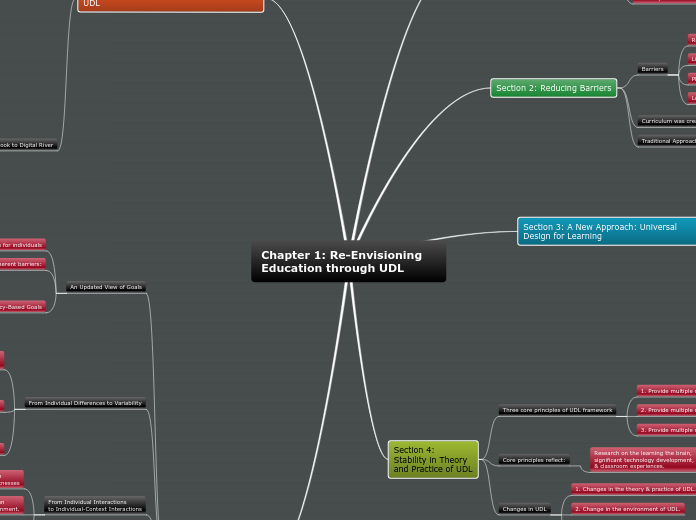Chapter 1: Re-Envisioning Education through UDL
Section 1:
The Beginning: New
Technologies as
Learning Tools
The Beginning
1984 - CAST originated
Reagan Administration - State of education in the U.S.
urged reform to guarantee educational opportunities.
1980's - Focus on diverse learners, struggling students, disability students.
Section 2: Reducing Barriers
Barriers
Reading challenges
Answer: text read aloud to them
Limited vocabulary needed
Answer: Linked definitions
Physical challenges
Answer: Single switch interfaces
Low vision
Answer: Large buttons
Curriculum was created
Traditional Approach
Section 3: A New Approach: Universal Design for Learning
Early 1990's -
Focus on Disability approach
New Approach: Universal
Design for Learning (UDL)
2002 Book publication:
Teaching Every Student in the
Digital Age: Universal Design for Learning
Students face barriers
Disabilities
Still some problems
1. Student taught in Standardize form & uniform ways.
2. Systematic application of UDL in school is the beginning.
3. UDL needs a stronger research base.
FUTURE EXPECTATIONS:
UDL will become a significant catalyst for far-reaching change
Section 4:
Stability in Theory
and Practice of UDL
Three core principles of UDL framework
1. Provide multiple means of engagement.
2. Provide multiple means of representation.
3. Provide multiple means of action and expression.
Core principles reflect:
Research on the learning the brain,
significant technology development,
& classroom experiences.
Changes in UDL
1. Changes in the theory & practice of UDL.
2. Change in the environment of UDL.
3. Changes in the media used to convey UDL.
Section 6: Changes in the Environment of UDL
Societal Changes and the Context of UDL
UDL itself has evolved over the past two decades and will continue to evolve.
In 2008, for the first time, a definition of the term universal design for learning was included under federal law in the Higher Education Opportunity Act.
In 2010, the U.S. Department of Education's National Education Technology Plan emphasized UDL as a framework that can benefit all learners, in particular those who have been underserved.
UDL and the internet
2013: People from more than 200 countries visited the CAST website
CAST Guideline translated into eight languages.
Publicly shared books written in 10 different languages (English, Spanish, Mandarin Chinese, and Russian).
New technologies will enable new visions and innovations for learning designs.
UDL was the malleability of digital media & will be forever flexible & adaptable for learners and educational needs
Internet changed the landscape, in terms of accessing information, share information, and social networking.
** UDL is not primarily about technology...It is about pedagogy. It is about raising expectations and learners reaching their goals. **
From Printed Book to Digital River
2002 - Published first book in UDL
Digital version key reasons
The digital version offers a dynamic, interactive
environment with options for different readers
and learning contexts.
The digital version is embedded in a rich
knowledge network—more like a hub
than a stand-alone source.
The digital version supports continuous development of UDL theory and practice through interaction with the UDL community worldwide.
The digital version enables us to seek your help to improve and grow this publication, enabling it to “learn.”
Section 5:
Changes in the Theory
and Practice of UDL
An Updated View of Goals
Early work focused on learning goals for individuals
Inherent barriers:
Text-base outcome & scaffold
Competency-Based Goals
Education goals shift from
knowledge acquisition
to learner expertise.
"Becoming an expert learner
is a process, not a fixed goal"
From Individual Differences to Variability
Early articulation of UDL
focuses on individual differences
Three kinds of neural networks in the brain
1. Extensive analysis of each learner
2. Focus on individual point in subtle ways
3. Student's have the same "profile"
Variability of learners
View variability as a positive force of learning
From Individual Interactions
to Individual-Context Interactions
Early work in UDL focuses on
learner's strengths and weaknesses
Learning occur in a dynamic interaction
between students and learning environment.
Environment changes lead to
physiological and psychological changes
From Cognition or Affect to
the Interdependency of
Cognition and Emotion
Society treats cognition &
emotion as seperate functions
Recognize the importance of
emotion and affect in learning.
"A chain is only as strong as its weakest link"
The UDL Guidelines
Move towards the close linkage of affect with recognition and with strategy
Guidelines help educators: design, choose, and implement effective teaching.
Guidelines help to manage resources and challenges in the learning environment to in a positive direction
UDL Guideline: Engagement - Needed for successful learning.
Guidelines offer a way for teachers & school systems to correctly represent how cognition and emotion are interrelated.
Bringing Assessment to the Fore
Four instructional components
1. Goals
2. Methods
3. Materials
4. Assessment
Recent years, components change to goals, assessment, methods, and materials.
Assessment is most important -
"formative assessment"
Council of Chief State Schools (CCSSO)
Essential to include students
and teachers in formative assessment.
